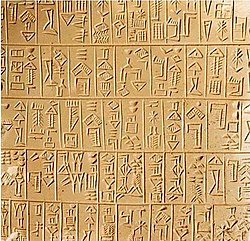
| History of literature by era |
|---|
| Ancient (corpora) |
| Early medieval |
| Medieval by century |
| Early modern by century |
| Modern by century |
| Contemporary by century |
| History of literature by region or country | ||||||
|---|---|---|---|---|---|---|
| General topics | ||||||
| ||||||
| Middle Eastern | ||||||
| European | ||||||
| ||||||
| North and South American | ||||||
| ||||||
| Oceanian | ||||||
| Asian | ||||||
| ||||||
| African | ||||||
| ||||||
| Related topics | ||||||
Sumerian literature constitutes the earliest known corpus of recorded literature, including the religious writings and other traditional stories maintained by the Sumerian civilization and largely preserved by the later Akkadian and Babylonian empires. These records were written in the Sumerian language in the 3rd and 2nd millennia BC during the Middle Bronze Age. [1]
Contents
- Poetry
- Literary genres and topics
- Literary catalogs
- Narrative and mythological compositions
- Historical compositions
- Letters and laws
- Hymns
- Disputation poems
- Proverbs
- Heterogeneous compositions
- See also
- References
- Sources
- Further reading
- External links
The Sumerians invented one of the first writing systems, developing Sumerian cuneiform writing out of earlier proto-writing systems by about the 30th century BC.[ citation needed ] The Sumerian language remained in official and literary use in the Akkadian and Babylonian empires, even after the spoken language disappeared from the population; literacy was widespread, and the Sumerian texts that students copied heavily influenced later Babylonian literature. [2] The basic genres of Sumerian literature were literary catalogues, narrative/mythological compositions, historical compositions, letters and legal documents, disputation poems, proverbs, and other texts which do not belong to these prior categories.